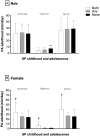Sports participation in childhood and adolescence and physical activity intensity in adulthood
- PMID: 38696508
- PMCID: PMC11065273
- DOI: 10.1371/journal.pone.0299604
Sports participation in childhood and adolescence and physical activity intensity in adulthood
Abstract
Objectives: The aim of the present study was to analyze the association between sports participation in childhood and adolescence and the practice of physical activity at different intensities in adulthood, and to verify if some sports participation characteristics such as number of sports; type of sport (individual, collective or a combination of both) and total estimated sports participation time are associated with the different physical activity intensities in adulthood.
Design: This is a cross-sectional study.
Methods: This study included 129 young adults of both sexes aged 18-25 years. Sports participation in childhood (7-10 years) and adolescence (11-17 years) was retrospectively estimated through specific questionnaire. Light, moderate, vigorous and moderate to vigorous intensity physical activity was objectively estimated by accelerometers. To verify the association between SP in childhood and adolescence and BP intensities in adults, multiple linear regression was adopted, with 5% significance.
Results: Analyses showed that, in females, sports participation in childhood (β = 0.315; R2 = 0.14; P = 0.020) and persistence in sports participation (β = 0.364; R2 = 0.18; P = 0.007) were positive predictors of vigorous physical activity in adulthood. In addition, the comparison according to the specificities of the sport practice, indicated that participation in two or more sports in childhood, one sport and collective sports in adolescence and at least one year of sports participation throughout childhood and adolescence were associated with longer time in vigorous physical activity intensity and MVPA (minutes/day) in adult females (P < 0.05).
Conclusions: It could be concluded that sports participation indicators in childhood and adolescence were considered predictors of vigorous physical activity in adult females. In addition, number of sports, type of sport and practice time in childhood and adolescence seem to predict vigorous and moderate to vigorous levels of physical activity for adult females.
Copyright: © 2024 Batista et al. This is an open access article distributed under the terms of the Creative Commons Attribution License, which permits unrestricted use, distribution, and reproduction in any medium, provided the original author and source are credited.
Conflict of interest statement
The authors have declared that no competing interests exist.
Figures


Similar articles
-
Can Sports Practice in Childhood and Adolescence Be Associated with Higher Intensities of Physical Activity in Adult Life? A Retrospective Study in Community-Dwelling Adults.Int J Environ Res Public Health. 2022 Nov 10;19(22):14753. doi: 10.3390/ijerph192214753. Int J Environ Res Public Health. 2022. PMID: 36429475 Free PMC article.
-
Associations of sport and exercise participation in adolescence with body composition and device-measured physical activity in adulthood: longitudinal data from the Norwegian HUNT study.Int J Behav Nutr Phys Act. 2025 Mar 5;22(1):29. doi: 10.1186/s12966-025-01726-7. Int J Behav Nutr Phys Act. 2025. PMID: 40045311 Free PMC article.
-
Developmental Trajectories of Physical Activity, Sports, and Television Viewing During Childhood to Young Adulthood: Iowa Bone Development Study.JAMA Pediatr. 2015 Jul;169(7):666-72. doi: 10.1001/jamapediatrics.2015.0327. JAMA Pediatr. 2015. PMID: 25984811 Free PMC article.
-
Participation in sports in childhood and adolescence and physical activity in adulthood: A systematic review.J Sports Sci. 2019 Oct;37(19):2253-2262. doi: 10.1080/02640414.2019.1627696. Epub 2019 Jun 8. J Sports Sci. 2019. PMID: 31179841
-
Types of leisure-time physical activity participation in childhood and adolescence, and physical activity behaviours and health outcomes in adulthood: a systematic review.BMC Public Health. 2024 Jul 4;24(1):1789. doi: 10.1186/s12889-024-19050-3. BMC Public Health. 2024. PMID: 38965532 Free PMC article.
Cited by
-
The relationship between physical education teachers' competence support and middle school students' participation in sports: A chain mediation model of perceived competence and exercise persistence.PLoS One. 2025 Jan 7;20(1):e0314338. doi: 10.1371/journal.pone.0314338. eCollection 2025. PLoS One. 2025. PMID: 39775358 Free PMC article.
-
Sex-Specific Physical Activity and Weight Status in German Schoolchildren: Interim Results from the Hand on Heart Study.Children (Basel). 2025 Mar 26;12(4):412. doi: 10.3390/children12040412. Children (Basel). 2025. PMID: 40310062 Free PMC article.
-
The link between childhood physical activity enjoyment and adult kinesiophobia in individuals with chronic low back pain.BMC Public Health. 2024 Sep 19;24(1):2557. doi: 10.1186/s12889-024-19953-1. BMC Public Health. 2024. PMID: 39300388 Free PMC article.
-
Social epidemiology of sports and extracurricular activities in early adolescents.Pediatr Res. 2025 May 4:10.1038/s41390-025-04099-6. doi: 10.1038/s41390-025-04099-6. Online ahead of print. Pediatr Res. 2025. PMID: 40319141
References
-
- Mahoney JL, Harris AL, Eccles JS. Director of SRCD office for policy and communications. Organized activity participation, positive youth development, and the over-scheduling hypothesis. Soc Policy Rep. 2006;20:3–32.

